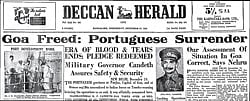The military action to decolonise Goa continues to provoke starkly contrasting views in India and Portugal

“In one swift operation, India ended 451 years of colonial rule,” Chief of Army Staff General V K Singh said here earlier this week at a ceremony in honour of defence personnel who had been part of Operation Vijay (the codename for the military strike to liberate Goa from Portuguese rule in 1961). The operation was unique, he said, carried out to free people within the country, and it had the support of local residents. Less than 48 hours after the air, sea and land strike launched against “Portuguese India” in the early hours of December 17, 1961, it was all over.
India lost just four military personnel. On the Portuguese side 31 soldiers had been killed. Portugal’s feeble military presence in Goa at the fag end of its long colonial rule was no match for an India just emerging from its long-won freedom. Portugal had barely 3,500 troops stationed here in December 1961. India had 45,000 men ready to close in on Goa.
An interesting account of the Indian air attack that completely snapped Portugal’s hopes of flying in reinforcements and supplies is reproduced in “Bharat Rakshak” from the official history of the Indian armed forces: “The Portuguese were suspected to have some supersonic interceptors initially. Later, it was believed that though fighters were not based, they maintained a regular supply chain by air. Facing this modest and insignificant air threat was amassed a huge Indian Air Force detachment. India had by that time six Hunter squadrons and four Canberra squadrons as its latest additions to the Air Force.”
On December 18, 1961, led by Wing Cdr N B Menon 12 Indian Canberras swooped down on Dabolim airport dropping 63,000 lbs of bombs on the runway. They took care to leave both the terminal and air traffic control untouched. “Menon noticed the presence of two large transport aircraft in the dispersal area. One Super Constellation and one DC-6 aircraft were parked on the apron. However, the Canberras left the aircraft alone,” the report says.
“A second raid by eight Canberras of No16 Squadron led by Wg Cdr Surinder Singh dropped more bombs on the runway. The Portuguese aircraft were again left untouched. By this time, it was assumed that the airfield was rendered unserviceable and these aircraft can be captured intact as they had nowhere to go. However, the Portuguese pilots of these aircraft proved to be foolhardy but brave. During nightfall, they managed to take off the aircraft from the still damaged airfield and made their getaway to Portugal.” The Air Force operations against Goa were commanded by Air Vice Marshall Erlic Pinto. Pinto died two years later in a helicopter crash.
Nehru’s decision to intervene militarily in Goa was preceded by years of both peaceful and armed resistance and diplomatic initiatives. India’s Independence would not be complete till Goa was freed, Nehru had said. In February 1950, India initiated negotiations for the return of the colonies, but the overtures were summarily rebuffed by Portuguese dictator António de Oliveira Salazar.
By 1953 India had snapped diplomatic ties with Portugal, withdrawing its mission in Lisbon. In 1954 came the visa restrictions and the economic blockade against Portuguese Goa that truncated supply lines with the rest of India. Even potatoes had to be shipped in from Holland and maida was sourced from Canada through Portuguese shipping lines that docked at Aden en route to Mormugao.
But what for India was the “liberation of Goa” is still perceived as an “invasion”by much of Portugal to this day. Grappling with its worst economic crisis, Portugal’s attention has been firmly focused on Goa’s golden jubilee celebrations with conferences and symposia dedicated to Indo-Portuguese history and Portugal’s mainstream media awash with reports and analyses of the 1961 takeover. One of Portugal’s leading newspapers, Diário de Notícias, had a whole supplement on the ‘1961 Portuguese Defeat’ while its leading television news channel RTP ran a series of recaps on “Goa 50 years ago” Another leading Portuguese publication Público revisited Goa with a long piece Um fado tropical (A tropical fado) that speaks of the current Goa with its ‘Indian ambience and Portuguese architecture’ as a state at a cultural crossroads. The Jornal de Notícias carried a full page on ‘The inevitable loss of India’. A not-so-flattering article “Hell in Paradise” beamed on corruption, illegal mining and Goa as a haven for Israeli druglords.
The milestone also saw the release of a number of books in Lisbon with journalist Paulo Aido producing his debut novel A primeira derrota de Salazar (Salazar’s first defeat), a historical romance steeped in Indo-Portuguese history and another publication bringing out As Macãs Azuis – Portugal e Goa – 1948-1961 on the life of Edila Gaitonde, the Portuguese wife of Goan freedom fighter Pundalik Gaitonde.
At one of the symposia held here to mark the half century of Goa’s independence, one of the panelists wondered why Goa still carried so much rancour against its former colonizers. The rest of India had moved on after Britain dismantled its Indian empire, he said. Colonialism in any form is reprehensible. But Portugal which ran Europe’s longest-lived colonial empires – it handed Macau over only in 1999 and granted sovereignty to East Timor as late as 2002 – also unleashed forced conversions with proselytising zeal in Goa. It forbade the use of Konkani, Goa’s official language and frowned upon the use of local costumes, in its strategy to “denationalise” (a term coined by prominent Goan freedom fighter Tristao de Braganza Cunha) Goans. Portugal’s colonial empire stretched from Brazil to Africa to India, including Angola, Mozambique, Cape Verde, East Timor, Macau and Guinea Bissau. The Indian enclaves were the first to go and the only ones where Portuguese is no longer the official language.
